Jul 9, 2021
The Disposable Japanese Home



Seeing carefully crafted old Japanese minka being demolished intact, when they looked perfectly fine days earlier, is always a surprise. Scrapping materials for use elsewhere doesn't seem like a priority.
Curtains, light fixtures, air conditioning units, even toilet paper are left as is, before the houses are demolished.
There are four locations within two minutes of where we live where these old houses, with heavy ceramic roof tiles intact, have recently been torn down. When I see this, it makes me want to claim any perfect sliding doors and removable hardware, not that I have any space or use for them.
If I could easily ship them off to America, I'm sure some people would pay to incorporate them into their homes.
It's really hard to understand from my perspective, growing up in a country where 100 year old houses are still valuable and home equity exists. Here there is little hope to get any original value in return if you want to sell a house, even a fairly new one.
Renovation does exist here. There are not many 'house flippers,' and I have only met one. This previous student was not actually a flipper. She worked as an architectural designer for a small family business inherited from her father and grandfather. She had building staff which took care of renovations and worked with the clients to design them. On one occasion, she told me the company bought an old house for a great deal, even though it was close to a station in a big city. They then renovated and rented the house out for a bit of regular income.
To do something like that without any experience and connections in Japan is not common. Still, I hear of young people and foreigners sometimes buying an old house to renovate. You can find plenty of popular magazines showing renovated old homes and condos.
Especially noteworthy is the “free house” option. This is not actually a free house, but in suburban and rural areas countrywide, abandoned houses (akiya) are becoming more and more common. They can be a burden on the city as property tax can't be collected if no owners can be found.
There are websites listing the cities (by prefecture) offering discounted vacant houses for sale. Some of these can be in terrible condition, requiring demolition and clearing overgrowth. Even if it was free, after these expenses, it's still not cheap land. Some might be in decent repair, but they are at least 40 years old.
If you're up for a huge project and want to buy a cheap home in rural Japan, maybe you can find a good deal?
I think it's a gamble as mold and insects have likely destroyed any houses sitting vacant for some time. I did a quick search and saw homes for 50,000 yen, which is crazy. Of course there must be a catch and the property is usually in less than desirable locations. These days, once internet is set up, for those working from home, this option might be more appealing. Maybe this is the way of the future.
The destruction all seems so wasteful in contrast to the resourceful Japan I know. I do enjoy the “dollhouse” views into the houses but don't think I'll ever get used to it.



1 Comment
TonetoEdo
on Jul 9
The second photo seems to show a house made from valuable timber. I've seen some newer buildings that have recycled beams and posts from classic kominka. I've lived in some houses that are 40 years old. Sorry to say, they're truly teardowns. Houses built in the 70s were made from cheap materials, roofs and floors fail due to quake and typhoon damage. I had the same thought as you - try to recover some fusuma and shoji from 1960s and 1970s houses about to be torn down in my neighborhood. Nothing was salvageable.